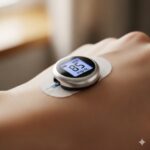Living with diabetes in 2025 offers more choices than ever before, and glucose monitoring devices on arm have become the centerpiece for convenient, real-time blood sugar management. These devices free users from the hassle and discomfort of routine fingerstick testing, providing a discreet and data-rich alternative that improves both health outcomes and quality of life. This article explores the best glucose monitoring devices on arm, examining how they work, their benefits, and how to choose the right device for individual needs.
Why Choose Glucose Monitoring Devices on Arm?
Modern glucose monitoring devices on arm deliver many advantages over traditional testing or abdominal sensors:
-
Comfort and Discretion: The upper arm is a convenient and less sensitive site, making sensor wear nearly unnoticeable throughout daily activities, sleep, and exercise.
-
Continuous, Real-Time Tracking: Frequent (often minute-by-minute) readings deliver timely alerts for highs, lows, and rapid trends, enabling proactive medication or dietary decisions.
-
Improved Control & Fewer Complications: More data points help users and healthcare teams adjust treatment strategies, improving Time in Range and reducing hospitalizations.
-
Integration with Digital Health: Most arm-based sensors sync easily with smartphones, wearables, and cloud platforms for real-time review, coaching, and remote support.
Top Glucose Monitoring Devices on Arm for 2025
Linx CGM
As one of the smallest and most discreet glucose monitoring devices on arm available, Linx CGM sets itself apart with a 22mm diameter, 4.2mm thickness, and featherweight comfort. It offers 15-day continuous use, water/sweat resistance (IP68), optional calibration, and one of the easiest-to-use apps for immediate data access and sharing. Real-world reviews praise its reliability, especially for active users and children.
FreeStyle Libre 3 Plus
A favorite across the globe, FreeStyle Libre 3 Plus features seamless arm application and delivers real-time glucose readings every minute for up to 14 days per sensor. It is factory calibrated (no finger pricks needed), highly water resistant, and transmits low/high alerts instantly to smartphones. Libre’s broad app ecosystem and robust sharing features make it especially useful for families and caregivers.
Dexcom G7
Dexcom G7 is widely recognized for high accuracy (MARD ~8.2%), swift 30-minute sensor warm-up, and sophisticated alerts predicting impending lows before they happen. The sensors, worn primarily on the upper arm, sync with major smartphones, some smartwatches, and leading insulin pump systems, providing rich analytics and coaching for daily glucose management.
Eversense 365
Unique in the market, Eversense 365 offers a fully implantable sensor for up to one year of continuous use, paired with a removable, rechargeable transmitter worn on the upper arm. It’s popular among tech-forward users or those seeking to minimize frequent sensor changes, though setup must be handled by a professional.
What Makes the Best Arm-Based Glucose Monitors?
Accuracy
Top glucose monitoring devices on arm stand out for their low mean absolute relative difference (MARD), translating into reliably precise day-to-day results.
Wear Duration
Longer sensor lifespan means fewer changes; the leading CGMs now last from 10 up to 15 days (or, in Eversense’s case, a year), adding convenience and reducing costs.
Smart Features
Customizable high/low/predictive alerts, on-demand reports, integration with diet/activity tracking, and remote support functionality are hallmarks of today’s best devices.
Waterproof Rating
IP68 or better ensures sensors can handle swimming, showering, and sweating, which is essential for active lifestyles.
App Integration
An intuitive, stable app and easy remote sharing for family or care teams is a must, making it easy to manage diabetes on the go.
Tips for Optimal Use
-
Apply to the suggested part of the upper arm on clean, dry skin for best adhesion and data quality.
-
Rotate sensor locations to minimize skin irritation or sensitivity over time.
-
Be proactive: Use smart alerts and review trends regularly, not just during emergencies.
-
Sync data frequently with your app or platform, keeping caregivers and clinicians in the loop.
Choosing the Right Device
Selection depends on lifestyle, data needs, price, and insurance coverage. Linx CGM’s minimalist design, sensor longevity, and waterproof comfort is ideal for those who demand convenience and discretion. FreeStyle Libre 3 Plus is praised for easy upgrades and broad support, while Dexcom G7 attracts users seeking maximum accuracy and the fastest alerts, especially those using insulin pumps.
If reducing sensor swaps is a top priority, Eversense 365 (with its professional implant) offers an innovative, ultra-long-term alternative.
The Future of Glucose Monitoring Devices on Arm
Innovation continues at a rapid pace: AI-powered digital coaching, multi-parameter sensors tracking hydration or ketones, and improved battery life promise an even more seamless, hands-off experience. Closed-loop integration (automated dosing) and telemedicine-ready features mean users can expect more autonomy and improved safety.
Conclusion
In 2025, glucose monitoring devices on arm redefine what’s possible for people managing diabetes, providing a blend of comfort, smart features, and clinical reliability once unimaginable. Exploring the top options—Linx CGM, FreeStyle Libre 3 Plus, Dexcom G7, and Eversense 365—can help anyone find their ideal solution for painless, precise, and connected diabetes control.

